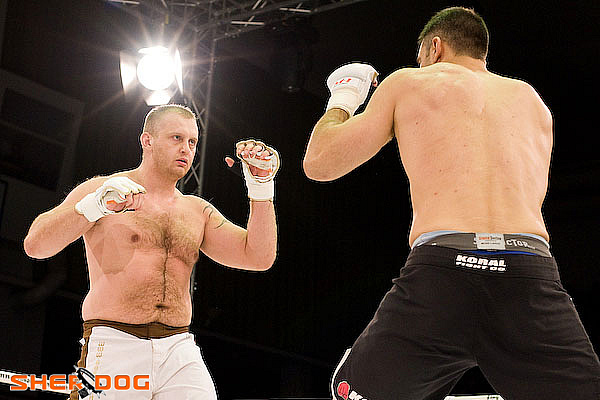The Fight for Poland’s Heavyweight Mantle
The Fight
Tomasz Marciniak Jun 9, 2010

Michal Kita (left) file photo: Heikki
Hujala/Sherdog.com
After former strongman Mariusz Pudzianowski’s embarrassing performance against Tim Sylvia in May, the words “Polish heavyweight” no longer conjure up a flattering image. Pudzianowski’s extreme exhaustion became the subject of many punch lines on both sides of the Atlantic.
Advertisement
A former freestyle wrestler -- though not an outstanding one, by his own admission -- Kita got his MMA start in old-school fashion. In November 2006, he was visiting a friend in England and happened to get himself on a ZT Fight Night card against Ryan White, whom he dispatched in 87 seconds.
“I pretty much walked into my first fight from the street,” he
says. “I wanted to test myself, and it seemed like a good way to
let off some steam.”
Kita clearly enjoyed himself. Two weeks later, he stepped into the cage again and won in 53 seconds. Ten months after, Kita packed his bags and left for Holland. There, he hooked up with Bert Kops, whose gym at the time was home to K-1 legend Peter Aerts -- a major factor in Kita’s choice.
“It’s the best place to hone your stand-up,” Kita says, “and I’d never even trained striking before.”
Over time, the amount of time spent training at Kops’ gym began to dwindle, as Kita supplemented it by sparring with Gegard Mousasi and working stand-up with current star Tyrone Spong and Harry Hooft -- Aerts’ former trainer. Though he has looked to flex his stand-up more recently, it seems that all his fights end up on the ground, where Kita employs his ground-and-pound as his chief weapon.
Kita’s breakthrough came in November, when he ran the table in the 2009 Mayor’s Cup tournament deep in the Siberian wilderness. Despite securing his visa a couple of days before the event, Kita won all three fights in a combined 6:25 over a tournament field that included former UFC heavyweight champion Ricco Rodriguez and Alexey Oleinik.
Russian promoters took notice, and an idea of a fight between Kita and Aleksander Emelianenko was soon floated. Kita ultimately declined due to persistent rumors of Emelianenko’s being positive for hepatitis.
“I really wanted that fight,” Kita says. “It would’ve been my biggest challenge.”
Thus far, Kita’s entire fighting career and much of his training has taken place outside of Poland, making him a rather mysterious figure to Polish fight fans. This mysterious aura is only reinforced by the terse way in which he speaks and the manner in which he carries himself. While attending a recent local MMA event in Poland, Kita shunned a front row seat, choosing to stand quietly in the back and avoid any possible attention. So far, Kita’s media presence for this bout has been limited to a single interview and promotional video released by Beast of the East.
Grabowski, a relative newcomer to MMA, started his professional career less than three years ago. Prior to his fighting career, he trained in a myriad of martial arts. He was particularly skilled in submission wrestling, a discipline in which he won national titles in 2006 and 2007. Like Kita, Grabowski earned quick recognition on the European circuit due to a sensational one-night tournament win.
File Photo
Grabowski was penciled in to fight veteran Valentijn Overeem on Beast of the East’s first offering in November but sustained a shoulder injury in training. In spite of the injury, he was back in the gym the next day running on the treadmill.
“If I lose my left arm, I’ll box with my right,” Grabowski says. “If I lose my right, I’ll throw leg kicks.”
The Kita-Grabowski showdown also represents a clash of different training philosophies. When speaking about the level of training in Poland, Kita does not mince words.
“We have to realize that here we’re about 20 years behind when it comes to professional training,” he says.
Kita is a believer in the benefits of full MMA sparring with the best fighters. Training boxing, jiu-jitsu and wrestling in separate sessions -- a practice Poland has only recently begun to steer away from -- unnerves the heavyweight.
In stark contrast, Grabowski not only relies on training in Poland but runs his own gym, Lutadores, in Opole in the southern part of the country. His outlook seems far from dire.
“I’ve been training alone all this time, and I keep winning,” he says. “You go on YouTube and you watch how others train and you copy them. As I glance over my bookshelf now, there’s at least 10 of them on sports physiology, training methodology and such.”
Grabowski remains unconvinced that quality of training partners is crucial, at least in relation to his bout with Kita.
“Look at [Dion] Staring,” he says. “He trains with the Overeems every day, and I subbed him twice.”
For this fight, however, he reached out to the Gameness Team in Poznan in order to train with heavier fighters, including the 6-foot-6, 285-pound Rafal Dabrowski. He also had an offer to train with Strikeforce heavyweight champion Alistair Overeem at Golden Glory, but money became an issue when Beast of the East officials, upon learning Grabowski had signed a contract with Bellator Fighting Championships, suddenly pulled the plug on financing the venture.
Related Articles






